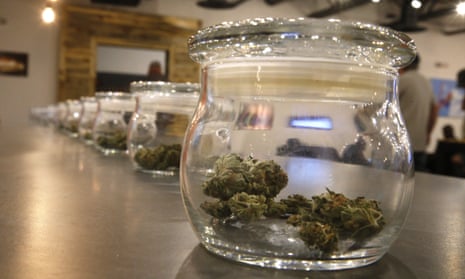Legal marijuana tax revenues have been breaking records in Colorado this summer, nearly doubling monthly numbers from last year and on pace to exceed projections of legal sales that bring revenue back to the state.
Through the first seven months of this year, Colorado has brought in nearly $73.5m, putting the state on pace to collect over $125m for the year.
In 2014, experts predicted legal cannabis would bring in upwards of $70m to the state’s tax coffers. In reality, the state collected just $44m in marijuana taxes.
Sales totals fell short of projections in 2014, the first year of legalized recreational sales in the state (and the nation) But this year, tax revenue from marijuana sales is exceeding initial projections of $70m.
Many in the marijuana industry attribute the sales boom to a tipping point in social acceptance.
“I attribute it to ... more and more people ... comfortable with the legalization of marijuana,” said Tyler Henson, president of the Colorado Cannabis Chamber of Commerce. “They don’t see it as something that’s bad for them.”
Tim Cullen, CEO of Colorado Harvest Company, said: “People who would never have considered pot before are now popping their heads in.” His company has three dispensaries in the Denver area and plans for a fourth. He noted that in his stores, where customers are primarily Colorado residents purchasing recreational marijuana, sales have been averaging 8% to 12% growth month over month for much of this year.
Support for marijuana legalization has grown in Colorado since voters approved Amendment 64 by a 10-point margin in November 2012. A poll from Quinnipiac University this February found that 58% of Coloradans support keeping cannabis legal, compared to just 38 percent who oppose the idea.
Early sales may have initially been dampened by the relative scarcity of dispensaries selling recreational marijuana. When retail sales began in January 2014, the only stores that were permitted to offer recreational marijuana were those with existing medical marijuana licenses. As a result, just a few dozen locations across the state offered recreational pot in the beginning of 2014.
“Ask any business owner now how hard it is getting your business approved and getting your license,” Henson, of the Colorado Cannabis Chamber of Commerce, argued. “We had a lot of new businesses and people getting on the market, but unfortunately weren’t able to come online right away.”
As the process has opened up, though, there are now hundreds of dispensaries across the state.
This growth in the number of marijuana stores has forced dispensaries to up their game in order to attract customers.
Cullen noted that, six years ago, when only medical marijuana was legal, “some of the stores looked more like college dorm rooms”. However, he argued, today’s customer is generally more sophisticated, looking for specific strains of cannabis and a more professionalized atmosphere. Unlike the young stoner stereotype, Cullen said, “our average customer is a business professional, and the vast majority are middle-aged folks with disposable income”.
Indeed, to shop in a 2015 dispensary is not unlike perusing a fine wine shop, with “budtenders” selecting particular varieties depending on an individual’s needs. Customers can expect to hear plenty of hoity-toity language about a strain’s “aromatic notes”. Dispensaries also employ other common customer attraction practices including weekly promotions and customer loyalty programs.
It’s likely that this boost in pot sales is not just coming from Colorado residents. In 2014, 71.3 million visitors spent $18.6bn in Colorado, both record highs that coincided with the first year of marijuana legalization. Figures for 2015 tourism haven’t been released yet.
In addition, even as medical marijuana sales have risen nearly 25% between May and July, it’s not being fueled by an increase in medical marijuana patients. The number of medical marijuana cardholders has stayed consistent at between 110,000 and 115,000 for many months.
Both Henson and Cullen said they expected cannabis sales to continue to increase, but they pointed to various issues that are holding back potential growth, including lack of access to credit cards and bank loans, as well as the inability to take certain federal small business deductions. “Our industry is very heavily regulated,” Henson argued. “It prohibits us from growing at a rate that we could be.”
And unlike liquor companies, which can openly advertise on billboards and television, marijuanasellers are forbidden to do so by law.
But sales will continue to rise in spite of regulatory hurdles if advocates are right that marijuana is becoming increasingly socially acceptable.
“You can’t show up to a dinner party with a few joints yet, like you would a bottle of wine,” Cullen said. “But we’re not far from it.”

Comments (…)
Sign in or create your Guardian account to join the discussion